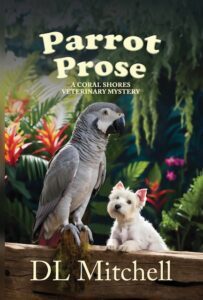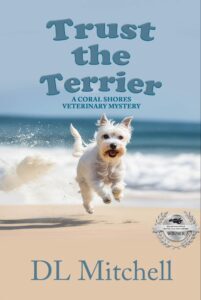Two Truths and a Lie: What Being a Veterinarian Taught Me About Writing Cozy Mysteries by DL Mitchell
 When people hear I’m both a veterinarian and a cozy mystery author, their eyes widen. A veterinary career is surprisingly great training for writing about amateur sleuths, quirky characters, and hidden clues. I love puzzles, but I also love a happy ending. Life can be unpredictable, but the satisfaction I get from treating patients and making a difference is like the hopefulness you feel after reading a cozy mystery—justice served, order restored, friendships forged, and maybe a slice of cake in a neighborhood cafe to celebrate.
When people hear I’m both a veterinarian and a cozy mystery author, their eyes widen. A veterinary career is surprisingly great training for writing about amateur sleuths, quirky characters, and hidden clues. I love puzzles, but I also love a happy ending. Life can be unpredictable, but the satisfaction I get from treating patients and making a difference is like the hopefulness you feel after reading a cozy mystery—justice served, order restored, friendships forged, and maybe a slice of cake in a neighborhood cafe to celebrate.
I’m going to share two truths and a lie about what my years in animal medicine taught me about crafting cozy mysteries. See if you can spot the fib.
Truth or Lie? Observing small details can save a life—or solve a mystery.
In veterinary school, you’re trained to notice what others miss. A cat isn’t “just tired,” and a dog doesn’t cough to get its owner’s attention. Both could signal injury or changes in lung function. Pets can’t tell us what’s wrong, but through a detailed exam, thoughtful questioning, and deductive reasoning, we can uncover the facts, leading to a successful treatment plan.
lung function. Pets can’t tell us what’s wrong, but through a detailed exam, thoughtful questioning, and deductive reasoning, we can uncover the facts, leading to a successful treatment plan.
Cozy sleuths also survive on details—a dog’s reaction to an uninvited guest, or the talking parrot who repeats a suspicious new phrase. Clues like these may be overlooked by an untrained observer but could help my amateur sleuth find the killer.
Truth or Lie? Every client is a character waiting to happen.
Veterinarians meet everyone—farmers, CEOs, retirees, college students—and they all love their animals. In the waiting room, people who might never speak to each other swap stories about their pets. As a vet, you get a front-row seat to the quirks and contradictions of human nature. The shy woman who comes to life showing photos of her new puppy dressed up for Halloween or the long-haul trucker who chokes up discussing his aging cat’s mobility challenges.
 In cozy mysteries, readers return to a series not only for a well-crafted plot but to spend time with their favorite cast of characters, both two- and four-legged. My career provides real-life personalities to draw from, many of which have ended up on the pages of my veterinary series. With their permission, of course.
In cozy mysteries, readers return to a series not only for a well-crafted plot but to spend time with their favorite cast of characters, both two- and four-legged. My career provides real-life personalities to draw from, many of which have ended up on the pages of my veterinary series. With their permission, of course.
Truth or Lie? Animals always make the perfect witnesses.
Real animals can’t give testimony, but as a veterinarian, I’ve learned they can give signals—just not in human words. A friendly cat that hisses when a particular person walks into a room. A horse that refuses to enter a certain stall. These moments can spark questions and add tension.
In my mysteries, the animal companions don’t “solve” the crime, but they often tip off the sleuth to something unusual. The trick is balancing believability with charm—without wandering into fantasy.
Which one was the lie?
If you guessed correctly, you know animals aren’t perfect witnesses in real life, even though their instincts should never be discounted. They can also be eccentric bystanders—observing events and responding to our cues and body language. I’ve seen dogs act guilty for no reason and cats ignore the most dramatic moments. But one thing is certain: they make delightful fictional co-investigators.
The other two? Absolute truth.
Being a veterinarian taught me to notice details and to appreciate the complex characters you meet along the way. And sometimes, the most unexpected career change makes the most perfect plot twist.
The post Two Truths and a Lie: What Being a Veterinarian Taught Me About Writing Cozy Mysteries by DL Mitchell appeared first on Debra H. Goldstein.



